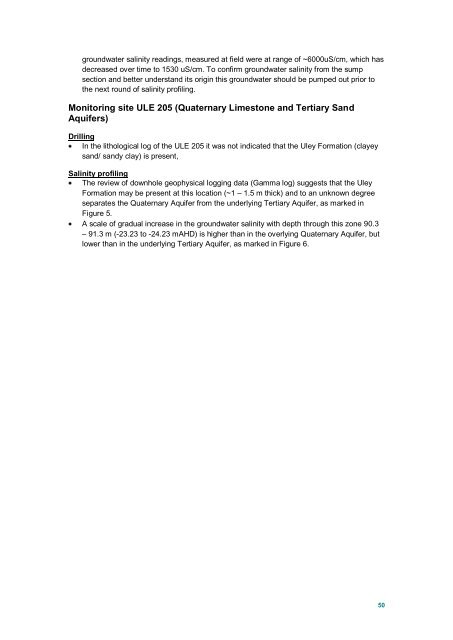Saltwater intrusion in Southern Eyre Peninsula, December 2009
Saltwater intrusion in Southern Eyre Peninsula, December 2009
Saltwater intrusion in Southern Eyre Peninsula, December 2009
Create successful ePaper yourself
Turn your PDF publications into a flip-book with our unique Google optimized e-Paper software.
groundwater sal<strong>in</strong>ity read<strong>in</strong>gs, measured at field were at range of ~6000uS/cm, which has<br />
decreased over time to 1530 uS/cm. To confirm groundwater sal<strong>in</strong>ity from the sump<br />
section and better understand its orig<strong>in</strong> this groundwater should be pumped out prior to<br />
the next round of sal<strong>in</strong>ity profil<strong>in</strong>g.<br />
Monitor<strong>in</strong>g site ULE 205 (Quaternary Limestone and Tertiary Sand<br />
Aquifers)<br />
Drill<strong>in</strong>g<br />
In the lithological log of the ULE 205 it was not <strong>in</strong>dicated that the Uley Formation (clayey<br />
sand/ sandy clay) is present,<br />
Sal<strong>in</strong>ity profil<strong>in</strong>g<br />
The review of downhole geophysical logg<strong>in</strong>g data (Gamma log) suggests that the Uley<br />
Formation may be present at this location (~1 – 1.5 m thick) and to an unknown degree<br />
separates the Quaternary Aquifer from the underly<strong>in</strong>g Tertiary Aquifer, as marked <strong>in</strong><br />
Figure 5.<br />
A scale of gradual <strong>in</strong>crease <strong>in</strong> the groundwater sal<strong>in</strong>ity with depth through this zone 90.3<br />
– 91.3 m (-23.23 to -24.23 mAHD) is higher than <strong>in</strong> the overly<strong>in</strong>g Quaternary Aquifer, but<br />
lower than <strong>in</strong> the underly<strong>in</strong>g Tertiary Aquifer, as marked <strong>in</strong> Figure 6.<br />
50

















